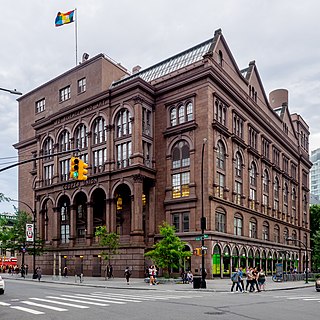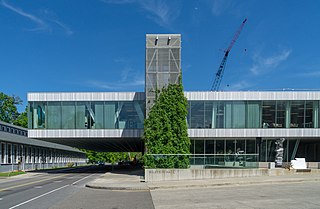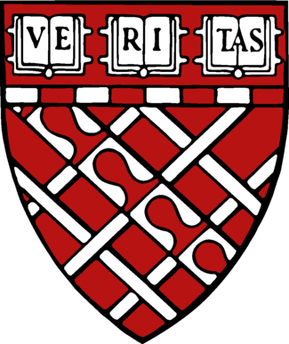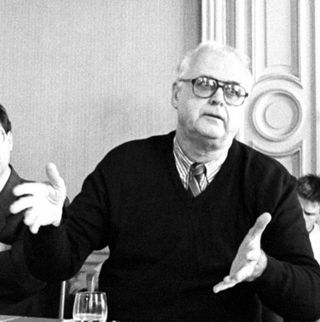
The Cooper Union for the Advancement of Science and Art, commonly known as Cooper Union, is a private college on Cooper Square in Lower Manhattan, New York City. Peter Cooper founded the institution in 1859 after learning about the government-supported École Polytechnique in France. The school was built on a radical new model of American higher education based on Cooper's belief that an education "equal to the best technology schools established" should be accessible to those who qualify, independent of their race, religion, sex, wealth or social status, and should be "open and free to all".

Peter David Eisenman is an American architect, writer, and professor. Considered one of the New York Five, Eisenman is known for his high modernist and deconstructive designs, as well as for his authorship of several architectural books. His work has won him several awards, including the Wolf Prize in Arts.

The University of Cincinnati is a public research university in Cincinnati, Ohio, United States. Founded in 1819 as Cincinnati College, it is the second oldest institution of higher education in the Cincinnati area and has an annual enrollment of over 50,000 students, making it the second largest university in Ohio. It is part of the University System of Ohio. The university's primary uptown campus and medical campus are located in the Heights and Corryville neighborhoods, with branch campuses located in Batavia and Blue Ash, Ohio.

Graduate School of Architecture, Planning and Preservation (GSAPP) is the architecture school of Columbia University, a private research university in New York City. It is regarded as an important and prestigious architecture school. It is also home to the Masters of Science program in Advanced Architectural Design, Historic Preservation, Real Estate Development, Urban Design, and Urban Planning.

The College of Architecture, Art, and Planning (AAP) is the school of architecture at Cornell University in Ithaca, New York. It offers 20 undergraduate and graduate degrees in five departments: architecture, art, urban planning, real estate, and design technology. Aside from its main campus in Ithaca, AAP offers programs in Rome, Italy and in New York City, New York.

The Harvard Graduate School of Design (GSD) is the graduate school of design at Harvard University, a private research university in Cambridge, Massachusetts. It offers master's and doctoral programs in architecture, landscape architecture, urban planning, urban design, real estate, design engineering, and design studies.
The Tyler School of Art and Architecture is based at Temple University, a large, urban, public research university in Philadelphia, Pennsylvania. Tyler currently enrolls about 1,350 undergraduate students and about 200 graduate students in a wide variety of academic degree programs, including architecture, art education, art history, art therapy, ceramics, city and regional planning, community arts practices, community development, facilities management, fibers and material studies, glass, graphic and interactive design, historic preservation, horticulture, landscape architecture, metals/jewelry/CAD-CAM, painting, photography, printmaking, sculpture and visual studies.

John Quentin Hejduk was an American architect, artist and educator from New York City. Hejduk studied at the Cooper Union School of Art and Architecture, the University of Cincinnati, and the Harvard Graduate School of Design. He worked in several offices in New York including that of I. M. Pei and the office of A.M. Kinney. He established his own practice in New York City in 1965.

Woodbury University is a private liberal arts university in Burbank, California. Founded in 1884 with initial campuses in Downtown and Central Los Angeles, Woodbury University is one of the oldest institutions of higher education in Southern California. The university consists of four schools: the School of Business, the School of Architecture, the School of Liberal Arts, and the School of Media Culture & Design.

The A. Alfred Taubman College of Architecture and Urban Planning, also known as Taubman College, is the school of architecture and urban planning and one of the nineteen schools of the University of Michigan located in Ann Arbor, Michigan.

The College of Fine and Applied Arts (FAA) is a multi-disciplinary art school at the University of Illinois at Urbana–Champaign.

The University of Cincinnati College-Conservatory of Music (CCM) is a performing and media arts college of the University of Cincinnati in Cincinnati, Ohio. Initially established as the Cincinnati Conservatory of Music in 1867, CCM is one of the oldest continually operating conservatories in the US.

The Contemporary Arts Center (CAC) is a contemporary art museum in Cincinnati, Ohio and one of the first contemporary art institutions in the United States. The CAC is a non-collecting museum that focuses on new developments in painting, sculpture, photography, architecture, performance art and new media. Focusing on programming that reflects "the art of the last five minutes", the CAC has displayed the works of many now-famous artists early in their careers, including Andy Warhol. In 2003, the CAC moved to a new building designed by Zaha Hadid.
Lois Rosenthal was an American author, publisher, arts & humanities philanthropist, and community volunteer. She was based in Cincinnati, Ohio. She served on the boards of the Cincinnati Art Museum, Cincinnati Playhouse in the Park, Freestore Foodbank, Art Links, Cincinnati Museum Center, and the Mercantile Library of Cincinnati. She was known for her hands-on philosophy of service in her community and was named Enquirer Woman of the Year in 1999 by The Cincinnati Enquirer.

The MIT School of Architecture and Planning is one of the five schools of the Massachusetts Institute of Technology in Cambridge, Massachusetts. Founded in 1865 by William Robert Ware, the school offered the first architecture curriculum in the United States and was the first architecture program established within a university. MIT's Department of Architecture has consistently ranked among the top architecture/built environment schools in the world.
The Emery Theatre, or Emery Auditorium, is a historic, acoustically exceptional theater located in the Over-the-Rhine neighborhood of Cincinnati, Ohio. The building was constructed in 1911 as the home for a trade school, but its large auditorium was intended for public use. The design of the Emery Theatre is based on the "isacoustic curve" principles that were first proposed by John Scott Russell. The theatre was built with two balconies and a total of 2,211 seats. It was one of the first concert halls in the United States to have no obstructed seats.
Alan Balfour is the former dean of the Georgia Tech College of Architecture. He has also held research and/or faculty positions at MIT, Rice University, Architectural Association School of Architecture, and Rensselaer Polytechnic Institute, and was instrumental in establishing the master's degree program in architecture at Georgia Tech.

The School for Creative and Performing Arts (SCPA) is a magnet arts school in Cincinnati in the US state of Ohio, and part of the Cincinnati Public Schools (CPS). SCPA was founded in 1973. Of the approximately 350 arts schools in the United States, SCPA is one of the oldest and has been cited as a model for both racial integration and for arts programs in over 100 cities.
Stephen J. Carter, AIA, NCARB, LF'82 is an American architect.
The School of Architecture and Interior Design (SAID) is a part of the College of Design, Architecture, Art and Planning (DAAP) at the University of Cincinnati. It is located within the Aronoff Center for the Arts in the university's main campus in Cincinnati, Ohio.
















